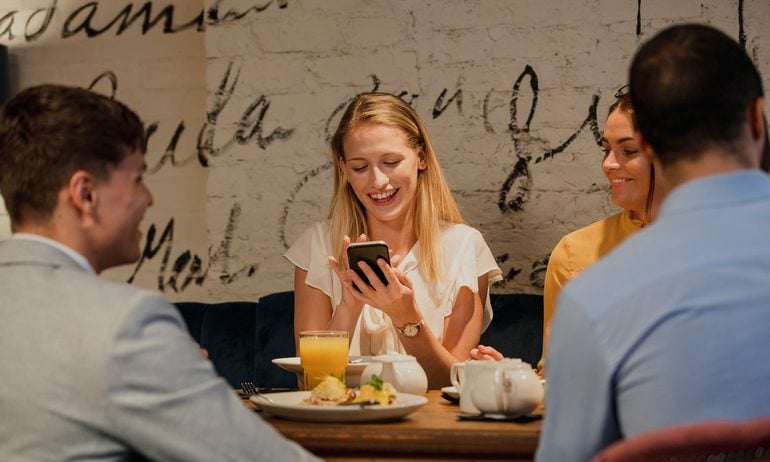Most Americans Go Mobile With Payment Apps — Here’s How They Roll

Many, or all, of the products featured on this page are from our advertising partners who compensate us when you take certain actions on our website or click to take an action on their website. However, this does not influence our evaluations. Our opinions are our own. Here is a list of our partners and here's how we make money.
Mobile payment apps allow people to send money quickly to other people, usually for free. These apps have become increasingly ubiquitous as online banking grows: Roughly 4 in 5 Americans (79%) use mobile payment apps, according to a new NerdWallet survey.
There are apps for making payments to merchants online or at a register, such as Samsung Pay, and apps for sending money to your friends and family (often called peer-to-peer or P2P apps), like Venmo and Cash App. Some apps, like Apple Pay and PayPal, can be used for both. Here, NerdWallet uses the umbrella term "mobile payment apps" to refer to all these uses.
In this survey of over 2,000 U.S. adults — about 1,600 of whom use mobile payment apps — commissioned by NerdWallet and conducted online by The Harris Poll, we asked Americans about their mobile payment app usage, including how they use the apps and whether they keep funds in their accounts. We also asked those who don’t currently use mobile payment apps what’s holding them back.

Member FDIC
Forbright Bank Growth Savings

4.25%
$0

Member FDIC
Axos ONE® Savings

4.66%
$1,500

Member FDIC
Varo Savings Account

5.00%
$0

Member FDIC
E*TRADE Premium Savings

4.00%
$0
Key findings
Millennials (ages 24-39) are the generation most likely to use mobile payment apps — 94% use them, compared to 87% of Gen Zers (ages 18-23), 88% of Gen Xers (ages 40-55) and 65% of baby boomers (ages 56-74).
Americans who use mobile payment apps primarily use them for online purchases through retailers (53%), paying friends/family members back (43%) and paying bills (40%).
About two-thirds of mobile payment app users (68%) say they have maintained a balance in their mobile payment app accounts. On average, those who use mobile payment apps have kept up to $287 in their account before transferring it to their bank account.
More than 2 in 5 Americans who don’t use mobile payment apps (42%) say the reason why is they don’t trust the security of the apps.
Mobile payment app users send money to family, shop online using an app
Mobile payment apps make it quick and easy to send money to people, without the need to mail a check or hand over cash. They can be ideal for splitting bills, paying back short-term loans or buying things online without a credit card.
More than 3 in 5 Americans who use mobile payment apps (61%) use them to send money to their significant other/family members, while around 2 in 5 use the apps to send money to online sellers (40%) or their friends (37%).
Over 2 in 5 mobile payment app users (43%) use these apps to pay friends/family members back, but sending cash to people we know isn’t the only purpose for these apps. More than half of users (53%) have used a mobile payment app to pay for an online purchase through a retailer, and 40% have used them to pay bills.
"Mobile payment apps are best suited for sending money to friends and family. For online purchases or bill payments, consumers are better off using debit cards or credit cards, which offer greater fraud protection," says Arielle O’Shea, NerdWallet’s banking specialist. "Credit cards also offer rewards like cash back, making them a good choice as long as you don’t carry a balance."
Majority use apps at least weekly
Most mobile payment app users use them frequently — close to 3 in 5 (58%) use them once a week or more often, while another 20% use them several times a month. Younger Americans are more likely to use mobile payment apps frequently than older Americans. More than two-thirds each of Gen Zers and millennials (67% and 71%, respectively) use them weekly or more often, compared to 37% of baby boomers.
Mobile payment app users keep hundreds in their app accounts
Around two-thirds of mobile payment app users (68%) say they’ve maintained a balance in their account, while 32% immediately transfer any money they receive. On average, users keep up to $287 in their account before transferring it to their bank account, with 46% of app users keeping $100+ in their account.
Among mobile payment app users, men tend to keep more money in their app accounts than women ($396 vs. $181, on average) and Gen Xers and millennials keep more money in their accounts than other generations ($405 and $337, respectively, versus $88 for Gen Zers and $189 for boomers, on average).
Most mobile payment app users do cash their balance out eventually — half (50%) cash out their entire balance once a month or more frequently. Just 6% never cash out their full balance.
"Most mobile pay apps don’t offer the fraud protection banks provide, and they don’t pay interest, which means maintaining a balance is less than ideal — you’re better off keeping your cash in a checking account or high-yield savings account," says O’Shea.
Some Americans opt out due to lack of need, lack of trust
Around 1 in 5 Americans (21%) don’t use mobile payment apps for various reasons. More than half of them (51%) don’t use mobile payment apps because they’re content with their current payment methods, and over 2 in 5 (42%) say it’s because they don’t trust the security of the apps.
"These apps are typically safe to use, and they have protections in place to shield your financial information. But like most things online, they’re not guaranteed against hacks, so it’s up to consumers to use apps wisely. That means setting unique passwords and taking other precautions," says O’Shea.
Consumer takeaways
Evaluate the app(s) you’re using: Each mobile payment app has its benefits and drawbacks, and you should use the one that’s best for your needs. Check out NerdWallet’s guide to P2P payment apps — which includes pros, cons and how to use them — to compare options.
Transfer your funds to a high-yield savings account if you won’t be using the money very soon: Most mobile payment app users transfer their balances at least occasionally, but if you’re racking up large balances in your app account, it’s a good idea to transfer that money out to a high-yield savings account regularly. It’s one thing to keep money in your account if you plan to transfer it to someone else in the near future, but otherwise it’s losing out on earning compound interest.
It’s also worth considering that your bank account is a safer place to house your cash. Bank accounts are protected by the Federal Deposit Insurance Corp., which means your money — up to $250,000 per account — is covered in the event a bank fails. With a mobile payment app, you may not have this protection, depending on the app you’re using and the laws of your state.
Consider the costs of linking a credit card to your mobile payment app: More than a third of mobile payment app users (36%) link their app to a credit card. A credit card probably isn’t the best way to fund a mobile payment app, because most such apps charge a fee of around 3% when you make a transfer with a credit card instead of a bank account. Check out the policies of your mobile payment app of choice before deciding which payment methods to add to your account.
Reduce your chance of security breaches: If you’re concerned about the security of online banking — and even if you’re not — take steps to protect your money against hackers when you use apps. Keep your apps up to date, don’t bank on "jailbroken" devices (those that have been hacked to remove software restrictions) and use unique passwords. Perhaps most importantly, monitor your bank accounts and report any suspicious or fraudulent activity immediately to your bank or credit union.
Methodology
This survey was conducted online within the United States by The Harris Poll on behalf of NerdWallet from Jan. 21-23, 2020, among 2,015 U.S. adults ages 18 and older, among whom 1,616 use mobile payment apps and 399 do not. This online survey is not based on a probability sample and therefore no estimate of theoretical sampling error can be calculated. For complete survey methodology, including weighting variables and subgroup sample sizes, please contact Marcelo Vilela at [email protected].
An earlier version of this story misstated the circumstances under which FDIC insurance protects consumers' money. It applies in the event of a bank failure. This article has been corrected.








